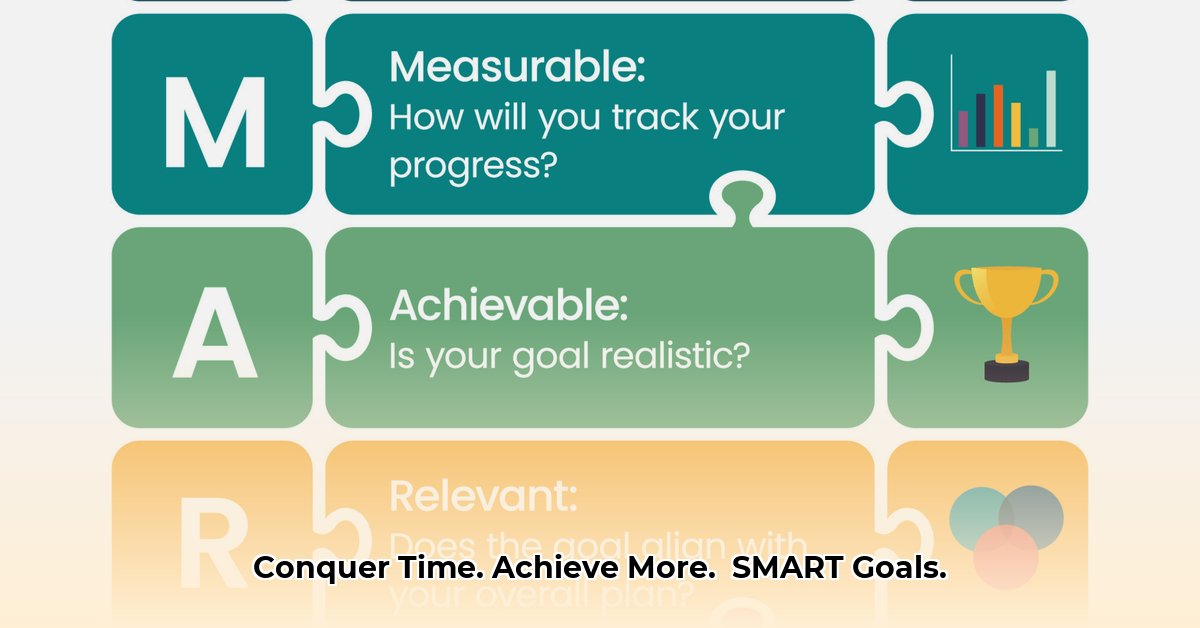Feeling overwhelmed? Constantly chasing deadlines and never quite catching up? You’re not the only one. Many people struggle to manage their time, which leads to stress and feeling burnt out. But guess what? There’s a simple, effective system to fix this. This guide will show you how to use SMART goals – that’s Specific, Measurable, Achievable, Relevant, and Time-bound – to take control of your time. We’re not just talking theory here; we’ll walk you through creating goals that actually work, show you common pitfalls to avoid, and give you practical strategies to boost your productivity and find a better work-life balance. Let’s get you organized and on track to achieve your goals!
SMART Goals for Time Management: Conquer Your Day
Feeling overwhelmed by your to-do list? Wish you had more hours in the day? You’re not alone! Many people struggle with time management, but the good news is that it’s a skill you can absolutely learn and improve. The key? Setting SMART goals. This isn’t about squeezing more into your already packed schedule; it’s about making smarter choices and prioritizing what truly matters. Let’s explore some time management improvement techniques.
Understanding the SMART System: Your Time Management Secret Weapon
SMART is a simple yet powerful acronym that helps you create goals that are effective and achievable. Let’s break down what each letter stands for:
-
Specific: Forget vague wishes like “be more organized.” Instead, be precise. A specific goal might be: “Finish writing the first draft of my short story by next Sunday.” Notice how clear and direct that is.
-
Measurable: How will you know if you’ve reached your goal? You need a way to track your progress. Instead of “read more books,” try “read one chapter of my book each evening.” You can easily track your progress each day.
-
Achievable: Be realistic! Don’t try to change everything overnight. Small, consistent steps are much more sustainable than overwhelming yourself with huge changes. Start with one or two manageable goals.
-
Relevant: Your goals should genuinely align with your bigger picture. Does this goal contribute to something important in your life, your career, or your personal growth? If not, it might be time to reconsider.
-
Time-Bound: Set a deadline! This creates a sense of urgency and helps keep you focused. Without a deadline, it’s easy to procrastinate. “Clean my desk by Friday afternoon” is much more effective than “clean my desk sometime”.
Crafting Your Personalized Time Management Goals: A Step-by-Step Guide
Now, let’s put the SMART system into action. First, let’s identify the things that are eating up your time. Are you constantly checking social media? Lost in endless email chains? Getting bogged down in unnecessary meetings? Once you pinpoint your time-wasters, you can start creating goals to tackle them. Improving focus requires diligent analysis.
Here’s a practical, step-by-step plan to craft your own SMART goals:
-
Time Audit – Where Does Your Time Actually Go?
Honestly assess how you spend your time. For a week, track your activities. You can use a simple notebook, a spreadsheet, or even a time-tracking app like Toggl Track or RescueTime. Be honest! Don’t just write down what should have happened, but what actually happened. This will give you a clear picture of where your time is currently going. Analyze the data to identify time sinks, such as excessive social media use, prolonged meetings, or inefficient task management.
2. Prioritize – Pick Your BattlesDon’t try to fix everything at once. That’s a recipe for failure. Choose one to three key areas to focus on. Maybe it’s reducing email clutter, improving your meeting efficiency, or minimizing social media distractions. Small wins lead to bigger achievements!
3. Become a Goal-Setting Master – The SMART WayFor each area you’ve chosen, create a SMART goal. Let’s say you want to reduce your time spent on email. Instead of “deal with email better,” a SMART goal might be: “I will respond to emails only twice a day (at 10 AM and 3 PM) and unsubscribe from at least five unnecessary mailing lists by the end of this month.”
4. Break It Down – Small Steps, Big ResultsBreak down your larger goals into smaller, manageable tasks. A big goal can seem daunting, but smaller tasks seem much more achievable. This makes progress feel more attainable and keeps you motivated. If your SMART goal is to write a report, break it down into research, outlining, writing the introduction, writing body paragraphs, editing, and proofreading.
5. Track Your Progress and Adjust as Needed – Be FlexibleUse a planner, calendar, or app like Google Calendar, Asana, or Trello, to monitor your progress. Are you on track? If not, what can you adjust? Flexibility is key. Life happens, and you may need to reschedule or modify your goals. Regularly reviewing your progress, and adjusting your approach, helps ensure you stay on track. Remember, it’s okay to adapt your plan along the way. An effective smart goals template facilitates progress tracking.
Examples of SMART Goals for Time Management
The following table shows some examples to give you a better idea of how to apply the SMART framework:
| Area of Improvement | SMART Goal | Measurement | Deadline |
|---|---|---|---|
| Reducing Email Overload | Respond to emails only three times per day (9 AM, 1 PM, and 5 PM) | Number of emails responded to outside these times | Next week |
| Improving Meeting Efficiency | Reduce weekly meeting time by one hour by using pre-set agendas and strict time limits | Total meeting time (in minutes) per week | End of the month |
| Minimizing Distractions | Dedicate 60 minutes each morning to focused work with all notifications turned off | Hours of uninterrupted work per week | Every weekday |
| Enhancing Work Breaks | Take a five-minute walking break every hour to improve focus and reduce eye strain | Number of walking breaks taken | Every workday |
The Ongoing Journey: Maintaining Momentum and Celebrating Success
Remember, consistency is key! Regularly review your goals (maybe weekly or bi-weekly). Celebrate even the small victories—this positive reinforcement will keep you motivated. Don’t get discouraged by setbacks. They’re valuable learning experiences. Review what worked well, what didn’t, and adapt your approach accordingly. Seek support from colleagues or mentors, and consider joining a productivity group for shared accountability and encouragement.
Mastering time management is an ongoing process, not a destination. By consistently applying the SMART framework and adapting your approach as needed, you’ll gradually transform your relationship with time, becoming more productive, less stressed, and far more accomplished. So, take that first step, create your SMART goals, and start conquering your day! Regularly practicing different time management skills will improve focus.
How to Adapt SMART Goals for Different Time Management Techniques
Key Takeaways:
- SMART goals are adaptable to various time management methods.
- Consistent monitoring and adjustments are crucial for success.
- Personalization is key to overcoming obstacles like procrastination.
- Combining goal-setting with techniques like time-blocking enhances effectiveness.
Understanding the SMART Framework
Before diving into adaptation, let’s refresh our understanding of SMART goals. They must be Specific, Measurable, Achievable, Relevant, and Time-bound. This framework ensures clarity and focus. Without it, your time management efforts can feel aimless. Achieving peak productivity at work requires dedicated analysis and practice.
Adapting SMART Goals for Different Time Management Techniques
The beauty of SMART goals lies in their adaptability. Let’s explore how to adapt smart goals for different time management techniques.
-
Time Blocking:
If you’re a time-blocking enthusiast, your SMART goals should align with your schedule. For example: “Complete the first draft of Chapter 3 between 9 am and 12 pm on Tuesday.” Notice how specific time slots are built right into the goal. This method makes your goals tangible and achievable within a defined timeframe. To further refine this goal, specify the word count or key sections to be completed within that block.
2. The Pomodoro Technique:This technique uses timed intervals (usually 25 minutes) of focused work followed by short breaks. Adapt your goals to fit these intervals. Instead of “Write a blog post,” try “Complete the introduction and first two paragraphs of the blog post during my first Pomodoro session.” Breaking larger tasks into smaller, manageable chunks is where the power of this technique truly lies. Set a timer for each Pomodoro session and track the number of sessions completed.
3. Eisenhower Matrix (Urgent/Important):This prioritization method helps categorize tasks. Your SMART goals should reflect this. A high-priority task might be: “Resolve the urgent client issue by 2 pm today (measurable, time-bound, relevant).” Less urgent tasks could have longer deadlines, reflecting their lower priority. This method helps you focus on what matters most, and setting SMART goals ensures you achieve that focus effectively. Learn about urgent important matrix examples. Re-evaluate tasks in each quadrant daily to adjust deadlines
- How To Balance Coaching And Personal Life For Well-Being - January 6, 2026
- Work Life Balance Coach Transforms Stress into Sustainable Well-being - January 5, 2026
- Work-Life Balance Solutions: Strategies for Achieving Personal and Professional - January 4, 2026
















